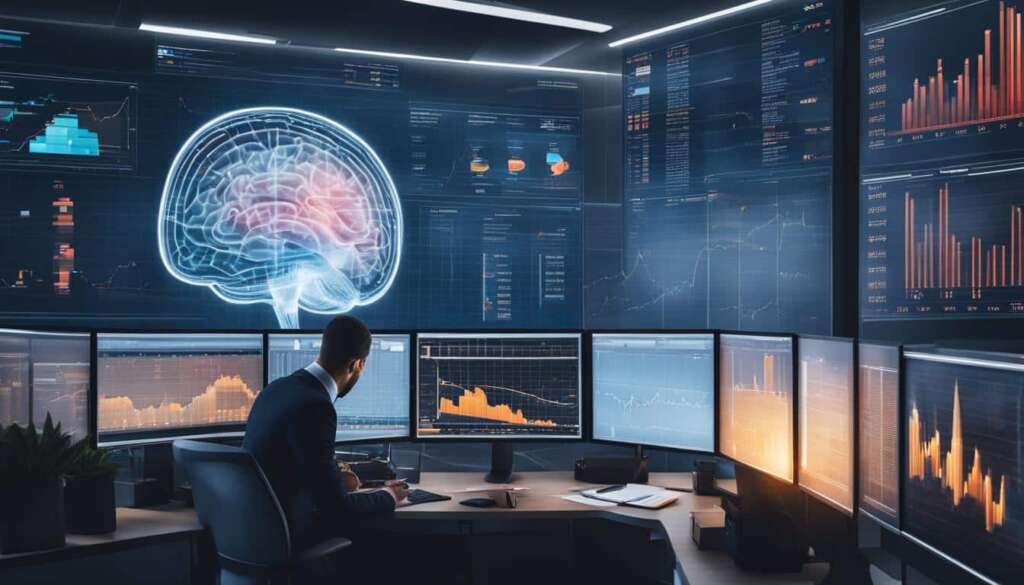Table of Contents
Deepfake technology, powered by artificial intelligence and machine learning, has revolutionized the realm of video manipulation and synthetic media. With the ability to digitally impersonate individuals through face swapping and image manipulation, deepfakes have become a subject of intrigue and concern.
As computer vision algorithms continue to advance, the accessibility and capabilities of deepfake technology have grown exponentially. Everyday individuals now have the means to create convincing deepfakes with readily available computer applications and tutorials.
Despite current limitations, such as the need for multiple training images, the potential for creating seamless and persuasive deepfakes looms on the horizon. This raises questions about the implications and risks associated with the widespread adoption of this technology.
Potential Harms of Deepfakes
Deepfake technology, with its ability to manipulate videos and create false information, poses significant potential harms to government institutions, public trust, and individuals. The spread of deepfakes can disrupt normal operations and lead to actions against a nation’s interest. Government institutions need to be wary of the impact that false information conveyed through manipulated videos can have on their credibility and the public’s trust.
Viewers of deepfakes are also at risk of suffering harm. If individuals make decisions or face negative consequences based on false information, it can have serious personal and societal repercussions. The prevalence of deepfakes in society can have psychological effects, making it harder for people to discern true information and access accurate information.
One specific area of concern regarding deepfake technology is deepfake pornography. Non-consensual deepfake pornography is a significant portion of deepfakes online, and it has severe consequences for the individuals whose identities are used without their consent. Such exploitation violates privacy rights and can cause immense harm to the victims.
| Societal Harms | Individual Harms |
|---|---|
| – Disruption of government operations – Erosion of public trust – Psychological effects on society |
– Negative consequences based on false information – Violation of privacy rights through non-consensual deepfake pornography |
“Deepfake technology presents a unique challenge in terms of maintaining the integrity of information and protecting individuals from harm. Government institutions must take proactive steps to address the potential risks associated with deepfakes, safeguarding public trust and ensuring the accuracy of information.”
It is crucial for society to address the potential harms of deepfakes and work towards solutions that can protect individuals and institutions. The development of robust detection tools, increased transparency in media sources, and stringent regulation can help mitigate the dangers posed by deepfake technology. Additionally, education and media literacy programs can empower individuals to identify and critically examine deepfakes, reducing their impact on public opinion and decision-making processes.
Potential Benefits of Deepfakes
Deepfake technology has the potential to revolutionize the film industry by enhancing visual effects and expanding creative possibilities. With deepfake algorithms, filmmakers can generate realistic landscapes, portraits, and animations that were previously unimaginable. This technology offers a cost-effective alternative to traditional visual effects techniques and opens up new avenues for storytelling.
Another benefit of deepfakes lies in personalized media. Consumers can now envision themselves as part of their favorite films or videos, creating a more immersive and engaging experience. This level of personalization enhances viewer enjoyment and provides a unique form of entertainment that caters to individual preferences.
Deepfakes also have applications in privacy preservation. By anonymizing faces or voices in media, individuals can maintain their privacy while still expressing themselves. This technology allows for the protection of sensitive information and fosters a culture of respect for personal boundaries in the digital age.
“Deepfakes have the potential to revolutionize the film industry through enhanced visual effects and personalized media.”
The medical field is another area where deepfake technology can make a significant impact. By modeling surgical outcomes or creating realistic datasets for AI diagnosis, deepfakes can improve patient care and contribute to advancements in medical research. This technology allows for the development of more accurate models and simulations, leading to better diagnoses and treatment plans.
| Industry | Potential Benefit |
|---|---|
| Film | Enhanced visual effects, personalized media |
| Privacy Preservation | Anonymization of faces or voices |
| Medical | Modeling surgical outcomes, realistic datasets for AI diagnosis |
Moreover, deepfake technology can be instrumental in combating misinformation. By developing robust detection tools and authentication methods, deepfakes can be identified and distinguished from real media. This capability empowers individuals to separate fact from fiction, strengthening public trust in the era of synthetic media.
In summary, while deepfake technology carries inherent risks, its potential benefits cannot be overlooked. From revolutionizing the film industry to enabling personalized media and advancing medical applications, deepfakes offer numerous opportunities for innovation and growth. By harnessing this technology responsibly, we can unlock its full potential and navigate the future of deepfakes with vigilance and ethical considerations.
Detection of Deepfakes
The rise of deepfake technology has raised concerns about the potential for misinformation and the manipulation of digital media. As deepfakes become increasingly sophisticated, detecting them has become a crucial challenge. Researchers and big tech companies are actively developing tools and algorithms to identify and flag deepfakes, but the accuracy of current detection methods is still a work in progress.
Detection of deepfakes involves analyzing various elements such as facial movements, lighting, audio inconsistencies, and digital artifacts. Machine learning techniques are employed to train algorithms to recognize patterns and anomalies that indicate the presence of deepfakes. These detection tools leverage advancements in computer vision and artificial intelligence to effectively identify manipulated media.
While progress is being made, there is a constant race between deepfake creators and detection developers. As new techniques and technologies emerge, detection methods must evolve to keep up with the ever-changing landscape of deepfake creation. The collaboration between researchers, technology experts, and big tech companies is crucial in staying ahead of the curve and mitigating the potential harms of deepfakes.
| Current Deepfake Detection Methods | Advantages | Limitations |
|---|---|---|
| Facial Recognition | Can detect facial inconsistencies and anomalies in deepfakes | Less effective when deepfakes involve partial face swaps or high-quality visual manipulation |
| Audio Analysis | Can identify audio inconsistencies or manipulation in deepfakes | Less accurate when deepfakes have high-quality voice synthesis |
| Digital Artifact Analysis | Can detect visual artifacts or anomalies caused by deepfake generation | May produce false positives or false negatives depending on the detection algorithm |
| Machine Learning Algorithms | Can learn patterns and characteristics of deepfakes for accurate detection | Require constant updates and training to keep up with evolving deepfake techniques |
Quote:
“The detection of deepfakes is an ongoing battle between creators and technology developers. As the technology advances, detection methods must keep pace to effectively combat the potential harms.” – Technology Expert
Transparency in Deepfakes
Transparency plays a crucial role in addressing the challenges posed by deepfake technology. As the prevalence of deepfakes continues to grow, it becomes increasingly important to establish trust in the authenticity of videos and media content. Verified accounts alone are not sufficient in the era of deepfakes, as even verified individuals or organizations can fall victim to the manipulation of their likeness.
To provide transparency and ensure the integrity of media, the usage of Non-Fungible Tokens (NFTs) has emerged as a potential solution. NFTs can encrypt videos and provide a unique identifier, allowing for easy comparison of different sources for the same moment. By integrating NFTs into the verification process, individuals can have more confidence in the authenticity and origin of the media they consume.
“The usage of NFTs could revolutionize the way we verify and trust videos in the era of deepfakes,” says Dr. Sarah Thompson, a leading expert in digital media authentication. “By incorporating NFTs into the verification process, we can provide users with a transparent and traceable record of the video’s origin, enhancing trust and mitigating the potential harms of deepfakes.”
Table: Comparing Deepfake Verification Methods
| Verification Method | Advantages | Challenges |
|---|---|---|
| NFT Integration | Enhanced transparency, easy comparison of sources | Requires widespread adoption and implementation |
| Blockchain-based Authentication | Immutable record of video origin | Reliance on blockchain infrastructure |
| Forensic Analysis | Detailed examination of video content | Requires specialized expertise and equipment |
| Metadata Verification | Examination of video metadata | Potential for metadata manipulation |
While NFT integration shows promise in providing transparency, it is important to note that the widespread adoption and implementation of such a system would be necessary to achieve its full potential. Additionally, other verification methods, such as blockchain-based authentication, forensic analysis, and metadata verification, also offer unique advantages and face their own set of challenges.
As the cat-and-mouse game between deepfake creators and detection technologies continues, it is imperative for researchers, technologists, and regulators to collaborate and explore innovative solutions to combat the potential harms of deepfakes. By promoting transparency and trust in the digital landscape, we can work towards a more secure and authentic media environment.
Regulation of Deepfakes
The rapid advancement of deepfake technology has raised concerns regarding the potential for misuse and harm. As a result, regulations and legislation are being introduced to address these issues. The focus of these laws is primarily on the harmful usage of deepfakes rather than restricting the technology itself. By targeting areas such as non-consensual use of women’s likenesses in pornography, digital fraud, and privacy violations, lawmakers aim to protect individuals and prevent the spread of false information.
One of the challenges in regulating deepfakes lies in updating existing laws related to fraud, defamation, and privacy to effectively address the unique characteristics of this technology. As deepfakes continue to evolve, it is crucial for regulations to keep pace with the advancements and adapt accordingly. Additionally, the collaborative efforts of governments, tech companies, and legal experts are essential in developing comprehensive regulations that strike a balance between protecting individuals and fostering innovation.
Regulations must also address the global nature of deepfakes, as they can be disseminated across borders with ease due to the digital nature of the content. International cooperation and agreements are necessary to ensure consistent standards and enforcement across jurisdictions. This includes sharing best practices, exchanging information, and collaborating on detection and prevention methods.
Current Regulatory Measures
To provide a better understanding of the current regulatory landscape, the following table outlines some key regulations and initiatives related to deepfakes:
| Country/Region | Regulation/Initiative | Description |
|---|---|---|
| United States | DEEPFAKES Accountability Act | Aimed at criminalizing the malicious use of deepfakes and providing resources for law enforcement agencies to combat deepfake-related crimes. |
| European Union | Audiovisual Media Services Directive (AVMSD) | Requires service providers to take appropriate measures to protect users from harmful content, including deepfakes, on their platforms. |
| Australia | Enhancing Online Safety (Non-consensual Sharing of Intimate Images) Act | Addresses the non-consensual sharing of intimate images, including deepfake pornography, by providing mechanisms for removal and punishment. |
| South Korea | Act on the Promotion of Information and Communications Network Utilization and Information Protection | Prohibits the creation and distribution of deepfakes without consent, with penalties for violators. |
These are just a few examples of the regulatory efforts underway to address the challenges posed by deepfakes. The interdisciplinary collaboration between legal, technological, and policy experts is fundamental in developing effective regulations and safeguarding against the potential harms of deepfake technology.
Education on Deepfakes
Education plays a crucial role in addressing the threats posed by deepfakes. By increasing public awareness and promoting media literacy, individuals can become more vigilant in consuming and identifying deepfakes. Platforms, organizations, and academic collaborations are working on developing and refining detection methods for deepfakes, with the aim of empowering individuals to distinguish between genuine and manipulated content.
The Importance of Media Literacy
Media literacy programs are essential in equipping individuals with the skills needed to critically evaluate the information they encounter online. These programs educate people about the potential risks associated with deepfakes and teach them how to spot signs of manipulation. By understanding the techniques and technologies used in deepfake creation, individuals can better assess the credibility of the content they consume.
Furthermore, media literacy empowers individuals to question the sources of information and encourages them to verify the authenticity of the content before accepting it as true. This helps in countering the spread of misinformation and false narratives that deepfakes can perpetuate.
Collaborative Efforts and Detection Tools
To combat the threat of deepfakes, collaborations between platforms, organizations, and academic institutions are essential. These partnerships are focused on developing detection tools and algorithms that can identify deepfakes with greater accuracy. By sharing knowledge and resources, these collaborations aim to stay one step ahead of the evolving deepfake technology.
Additionally, open-source initiatives are encouraging the development of innovative approaches to detect deepfakes. By involving experts, researchers, and members of the public in the creation of detection tools, these initiatives promote a collective effort to combat the spread of manipulated content.
Empowering Individuals in the Digital Age
Ultimately, education on deepfakes is about empowering individuals to navigate the digital landscape more confidently. By providing individuals with the knowledge and tools to identify deepfakes, we can mitigate the potential harm caused by misinformation and manipulation. Through ongoing education and collaboration, we can work towards a society that is better equipped to recognize and combat the threats posed by deepfakes.

| Education on Deepfakes | Benefits |
|---|---|
| Increased public awareness | Empowers individuals to identify deepfakes |
| Promotes media literacy | Enables critical evaluation of online content |
| Collaborative efforts | Fosters the development of effective detection tools |
| Open-source initiatives | Promotes innovation in deepfake detection |
| Empowering individuals | Enables a confident navigation of the digital landscape |
Current Efforts and Challenges
Various organizations and academic institutions are actively engaged in developing advanced detection tools to combat the rising threat of deepfakes. The rapid advancement of deepfake technology necessitates the continuous improvement of detection methods to keep pace with evolving techniques. However, achieving higher accuracy in detecting deepfakes remains a significant challenge.
Despite the ongoing efforts, current detection tools are not always foolproof and can struggle with the ever-evolving sophistication of deepfake creation. The complex algorithms used to generate deepfakes often surpass the capabilities of existing detection methods, making it crucial to invest in research and development to enhance detection accuracy.
Technological advancements pose another challenge in the fight against deepfakes. As deepfake algorithms continue to evolve, it becomes increasingly difficult for detection tools to stay ahead. The constant need to update and upgrade detection algorithms is essential to effectively combat the ever-changing landscape of deepfake technology.
The Continuous Race for Advancement
The battle against deepfakes is a constant race between technology creators and detection developers. Each advancement in deepfake technology presents new challenges for detection, necessitating continuous improvement and innovation in detection tools.
Organizations and academic institutions working on deepfake detection face the task of consistently refining and updating their algorithms to adapt to emerging deepfake techniques. Collaboration between researchers and industry professionals is crucial to stay ahead of malicious actors who seek to exploit the technology.
While the challenges are significant, the dedication and efforts of various stakeholders in deepfake detection provide hope for the future. By continually pushing the boundaries of detection technology, we can mitigate the potential harms associated with the widespread proliferation of deepfakes.
Future of Deepfake Technology
The future of deepfake technology holds both promise and concern. As advancements continue to push the boundaries of what is possible, it is essential to consider the potential societal impact of deepfakes. While deepfake technology has applications in various fields, including entertainment and healthcare, its misuse can have far-reaching consequences.
Advancements in deepfake technology are expected to make the creation of highly convincing deepfakes more accessible. This raises concerns about the spread of misinformation, the erosion of trust in media, and the potential for deepfakes to be used for malicious purposes. As deepfakes become more sophisticated, it will become increasingly difficult to discern real from fake, leading to potential social and political destabilization.
On the positive side, deepfake technology has the potential to revolutionize industries such as film and advertising, allowing for more realistic special effects and personalized media experiences. It can also have positive applications in areas such as medical research, where it can aid in the development of new treatments and diagnostic tools. However, careful consideration must be given to the ethical implications of using deepfakes in these fields.
In order to navigate the future of deepfake technology responsibly, it is crucial to continue developing robust detection tools, educating the public about deepfakes and their potential impacts, and implementing regulations to prevent misuse. By taking proactive measures, we can harness the benefits of deepfake technology while mitigating the risks it poses to individuals, society, and our collective trust in media.
| Advancements | Societal Impact |
|---|---|
| Increasing accessibility of deepfake creation tools | Erosion of trust in media |
| Development of more convincing deepfakes | Potential for social and political destabilization |
| Revolutionizing industries like film and advertising | Spread of misinformation |
| Potential applications in medical research | Need for robust detection tools and regulation |
Ethical Considerations
As deepfake technology continues to advance, ethical considerations surrounding its use become increasingly important. Responsible use of deepfakes requires careful consideration of consent, privacy, and the potential for misuse.
In terms of consent, deepfakes raise concerns about the use of someone’s likeness without their knowledge or permission. Non-consensual deepfake pornography, for example, is a significant issue that violates individuals’ privacy and can cause significant harm. It is crucial for individuals, organizations, and governments to establish clear guidelines and regulations to protect people from the non-consensual use of their images or voices in deepfakes.
Privacy is another critical aspect to consider when it comes to deepfakes. As the technology becomes more sophisticated, there is an increasing risk of deepfakes being used to invade individuals’ privacy by creating fabricated videos or audio recordings that appear genuine. Safeguards must be in place to prevent the misuse of deepfakes for spying, harassment, or other malicious purposes.
“Responsible use of deepfake technology requires careful consideration of consent, privacy, and the potential for misuse.”
Additionally, there is a need to address the potential for deepfakes to be used for harmful purposes, such as spreading misinformation or defamation. The responsible use of deepfakes involves ensuring that they are used in ways that do not harm individuals, society, or public trust. Developing guidelines and ethical frameworks for the creation, distribution, and consumption of deepfakes can help mitigate the risks and potential harms associated with this technology.
To navigate the ethical implications of deepfakes, collaboration between technology developers, policymakers, and ethicists is essential. Open discussions, public awareness campaigns, and educational initiatives can help raise awareness about the ethical considerations of deepfakes and promote responsible use. Ultimately, the responsible use of deepfake technology requires a balance between innovation and safeguarding individuals’ rights and well-being.

Conclusion
Deepfake technology presents both potential benefits and risks for society. On the one hand, it has applications in various industries, such as the film and medical fields, where it can enhance visual effects and aid in medical research. However, the misuse of deepfakes can have serious implications.
The future implications of deepfake technology depend on the collective actions taken by stakeholders. Detection tools and algorithms are being developed to identify deepfakes, but the technology is evolving rapidly, posing challenges in staying ahead of new deepfake techniques.
Transparency and regulation are also crucial. The use of techniques like NFTs can provide transparency in verifying the source of videos, while regulations are being introduced to address privacy violations, fraud, and non-consensual use of deepfake technology.
Education and ethical considerations play a key role in navigating the future of deepfakes. By increasing public awareness, promoting media literacy, and ensuring responsible use, individuals, organizations, and governments can mitigate the potential harms and ensure the ethical use of deepfake technology.
FAQ
What are deepfakes?
Deepfakes are manipulated videos, photos, or audio recordings created through AI, often involving the synthesis or replacement of speech and faces.
How accessible is deepfake technology?
Deepfake technology has become increasingly accessible, with computer applications and tutorials now widely available for creating deepfakes.
What are the potential harms of deepfakes?
Deepfakes pose potential harms to government institutions, viewers who may make decisions based on false information, and society as a whole in terms of psychological effects and non-consensual deepfake pornography.
Are there any potential benefits of deepfakes?
Deepfakes have potential benefits in various industries such as film, privacy preservation, personalized media, and medical applications.
How can deepfakes be detected?
Several researchers and big tech companies are working on developing detection tools and algorithms for deepfakes.
How can transparency help combat deepfakes?
Transparency in the source of videos can be achieved through techniques like NFTs, which verify origins and allow easy comparison of different sources.
What regulations are being introduced to address the misuse of deepfakes?
Regulations range from criminalizing the non-consensual use of women’s likenesses in pornography to dealing with digital fraud and privacy violations.
How can education address the threats posed by deepfakes?
By increasing public awareness and promoting media literacy, individuals can become more vigilant in consuming and identifying deepfakes.
What are the current efforts and challenges in detecting deepfakes?
Various organizations are actively working on developing advanced detection tools, but the challenges lie in achieving higher accuracy and staying ahead of new deepfake techniques.
What is the future of deepfake technology?
The future of deepfake technology is uncertain, and it will depend on ongoing efforts to regulate and mitigate potential harms and promote responsible use.
What ethical considerations are associated with deepfake technology?
Deepfake technology raises ethical considerations such as consent, privacy, and the potential for misuse. Responsible use and respect for privacy rights are important in navigating these implications.
Source Links













